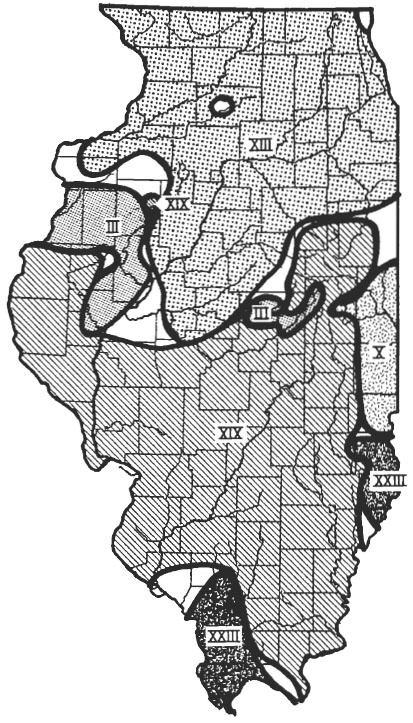The Northern Illinois Brood
Brood XIII was historically recorded in Michigan, and older maps (Marlatt 1923; Simon 1988) show intriguing populations following the Michigan/Indiana border. However, searches in 2007 failed to confirm the existence of these populations, although populations have recently been reported from counties surrounding the Michigan, Indiana, and Ohio shared border (Moore 2016). This brood includes the species Magicicada cassini, Magicicada septendecim, and Magicicada septendecula.
Brood XIII also has one of the largest and best documented off-cycle or “straggling” emergence. In 1969, four years before the 1973 emergence, millions of cicadas emerged and formed choruses in the near western suburbs of Chicago (Dybas 1969). Subsequent searches of these areas have revealed significant numbers of off-cycle cicadas, including light choruses in 2003 (Cooley et al. 2016).
In the map below, cicada symbols are verified presence records and red symbols are verified absence records in our database as of March . Click on points for details. Gold symbols are from Simon (1988); smaller symbols are records with a lower degree of certainty and black crosses represent records that are considered spurious. Blue symbols are from Marlatt (1923); smaller symbols are records with a lower degree of certainty and question marks represent records that are considered spurious. Purple symbols and shading represent Stannard’s (1975) delineation of the brood in Illinois. Symbols are in layered in the order Database, Simon, Marlatt, Stannard and symbols in the upper layers may obscure symbols in lower layers. Some absence records in the database are not shown for clarity. Note that the dates shown do not represent dates of adult emergence; rather, they represent dates on which choruses were active. Thus, in any given area, adult emergence may have occurred a week or more earlier than the dates shown on this map. This map may not be reproduced without written permission.

Illinois presents a particular challenge for understanding periodical cicada biology, because it contains both 13 and 17 year life cycles, all 7 currently recognized species, and five separate broods, some of which include disjunct populations.
Stannard (1975) published a map of all Illinois periodical cicada broods. Stannard’s map of Brood XIII closely matches the distribution as currently understood, although some areas delineated as Brood XIII belong to Brood III.